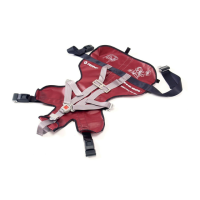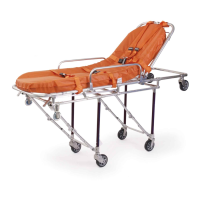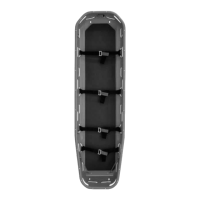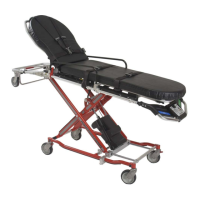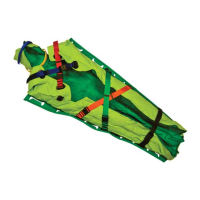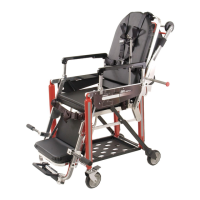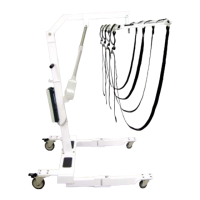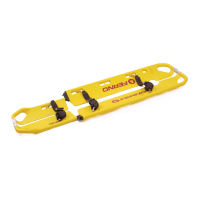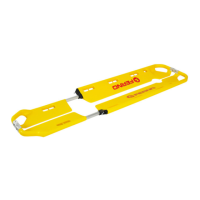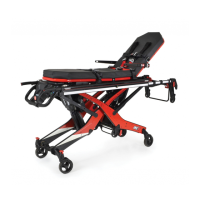Do you have a question about the Ferno Mondial MB64 and is the answer not in the manual?
Alerts to potentially hazardous situations that could result in injury or death if not avoided.
Emphasizes crucial usage or maintenance information; failure to follow can cause product or property damage.
Provides recommendations for easier use of the product.
Advises on reducing exposure to infectious materials by following cleaning and disinfecting instructions.
Warns against combining different manufacturer's products due to increased risk of injury and damage.
Defines symbols used on the cot and in the manual, recognized by ISO, ANSI, and EMS industries.
Explains the purpose of labels on the cot and the importance of reading and following them.
Outlines requirements for operators, including manual understanding, proper use, and emergency procedures training.
Discusses the physical demands on operators, especially shorter ones, during lifting and unfolding cot legs.
Defines key terms used in the manual, such as Control End, Load, Load Capacity, and Operators.
Provides guidance on using helpers for operating the cot, including suggested placements and operator roles.
Introduces the Mondial Monobloc Series Cot as an emergency patient-handling device for ground-based ambulances.
Details the cot's compliance with Medical Device Directive 93/42/EEC and US safety standards.
Presents detailed specifications including load capacity, weight, dimensions, and ambulance floor range for models MB64 and MB70.
Illustrates and describes various cot positions, including folded, Bed Position 1, Bed Position 3, and Bed Position 6 (rolling).
Specifies requirements for the ambulance patient compartment, including floor level and fastening system.
Guides on installing the pad, patient restraints, and accessories, emphasizing proper use and safety guidelines.
Provides step-by-step instructions for attaching the two-piece leg restraint to the cot using provided brackets.
Details how to attach the shoulder and waist straps of the harness restraint using the bracket button system.
Explains the purpose and use of the EZ Pull handles for unlocking legs to lower or raise the cot.
Describes the indicator that shows the status of the leg lock (GREEN for locked, RED for unlocked).
Details the function of the lever that unlocks loading-end casters for swiveling, and guidelines for its use.
Explains how to engage and disengage wheel locks for securing the cot during transfers and procedures.
Describes the purpose of sidearms for patient security and how to lower and raise them, with a warning not to use them for lifting.
Explains the function of the built-in footrest for patient support and as a steering aid for the operator.
Details the adjustment of the shock frame to Raised (Trendelenburg) and Contour (Fowler's) positions for patient comfort or medical needs.
Explains how the backrest elevates the patient's torso using a red control handle, with safety notes.
Describes the optional feature to extend the headrest for taller patients, increasing surface length.
Details the optional frame allowing three backrest positions for airway access.
Explains the purpose of intermediate loading wheels in reducing lifting effort during ambulance loading/unloading.
Describes the optional leg lock that secures cot legs in specific positions for lifting and carrying.
Details the optional telescoping handles that extend to aid lifting and carrying, locking in three positions.
Explains the use of optional side handles for extra lifting or grasping points during cot operation.
Describes the mechanism that automatically unlocks loading-end legs for folding during ambulance loading.
Explains the optional feature where control-end legs automatically unlock and fold during loading.
Details the optional device preventing accidental unloading by catching on an ambulance plate.
Describes the optional storage tray integrated under the backrest for placing objects.
Outlines essential pre-service checks, including manual understanding, setup, and vehicle compatibility.
Provides general advice for operating the cot, emphasizing safety, communication, and restraint use.
Details the procedures for raising and lowering the cot, requiring two operators and communication.
Provides step-by-step instructions for safely transferring a patient onto the cot, including securing restraints.
Explains guidelines and procedures for rolling the cot with a patient, emphasizing safety and operator coordination.
Details the process for loading the cot into an ambulance, including operator roles and Smart-Load system use.
Provides step-by-step instructions for safely unloading the cot from an ambulance with a patient.
Explains how to engage the leg lock for lifting and carrying the cot over obstacles or rough terrain.
Details procedures for loading, unloading, and changing positions of an empty cot by a single operator.
Outlines minimum intervals for regular cot maintenance tasks like disinfecting and inspecting.
Describes the optional Tracker device for counting cot cycles and aiding in maintenance scheduling.
Provides instructions for disinfecting and cleaning the patient restraints.
Gives instructions for disinfecting and cleaning the cot's pad.
Instructs on wiping down all surfaces of the cot with disinfectant.
Details how to hand clean all surfaces of the cot using warm water and mild detergent.
Suggests waxing painted legs for appearance, after cleaning and disinfecting.
Recommends regular inspection by maintenance personnel and provides a checklist for cot functions and safety.
Lists lubrication points and specifies appropriate lubricants, along with items that do not require lubrication.
Provides contact information for ordering parts and professional repairs in the USA and Canada via EMSAR.
Directs users to contact their Ferno distributor for ordering parts and professional repairs globally.
| Brand | Ferno |
|---|---|
| Model | Mondial MB64 |
| Category | Medical Equipment |
| Language | English |
